
Original Link: https://www.anandtech.com/show/2331
Intel Developer Forum 2007 - Day 1: Nehalem, Intel's GPUs, 32nm and More
by Anand Lal Shimpi on September 18, 2007 1:17 PM EST- Posted in
- Trade Shows
We're privy to a special IDF this year, it's the 10 year anniversary of the conference and Intel is understandably excited. The show started off with Intel's President and CEO, Paul Otellini giving us a broad update on the company and its roadmap.
45nm: The Enabler
Otellini confirmed what we already know, that Intel's 45nm process will be the enabler to bring us technologies such as integrated graphics on CPUs (similar to AMD's Fusion strategy), octo-core CPUs, system on a chip designs and a highly parallel x86 design that we've come to know as Larrabee.

Intel's integrated graphics on 45nm announcement isn't anything new, Intel originally told us that certain versions of Nehalem would be available with integrated graphics and we expect to see that
Silverthorne is Intel's very simple x86 system-on-a-chip design, which will hopefully make its way into everything from smart phones to digital TVs. UMPCs may also use Silverthorne for particularly mobile form factors, hopefully fixing many of the problems with today's UMPCs.
32nm on track for 2009
Intel confirmed that its manufacturing expertise is still strong and that it fully expects to introduce the first 32nm products in 2009, just two years from now.
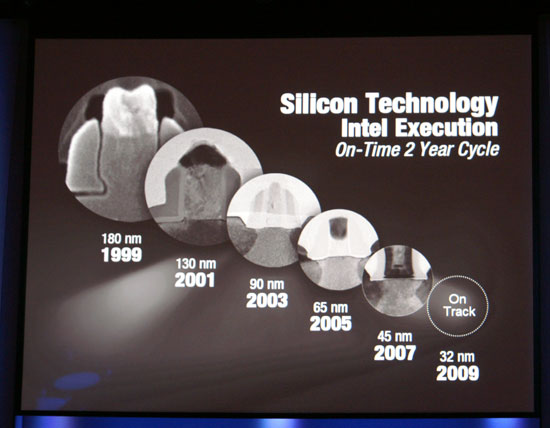
As always, when you're bringing up a new process you want to try manufacturing simpler devices first and thus Intel showed off a SRAM wafer built on its 32nm process. Each die on the wafer had a 291Mbit SRAM composed of an incredible 1.9 billion transistors.
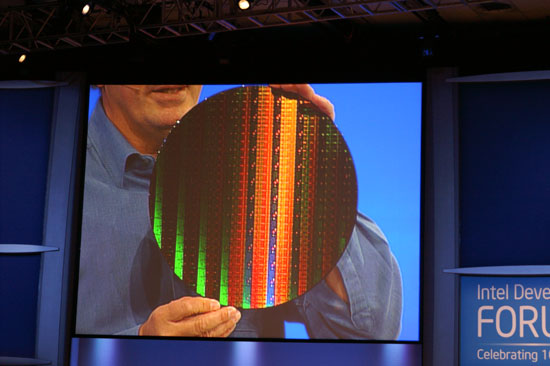
The Penryn Update
Penryn is coming, we've previewed it already and we should get more performance data at the show. The official launch date is November 12th, and Penryn is the first of 20 microprocessors being developed on 45nm. The introduction in November will be for servers and high end desktops, followed by a mainstream release in Q1 2008.
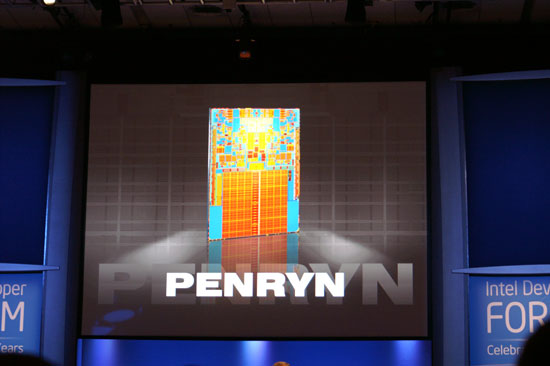
Intel also confirmed that its 45nm processors and the 65nm chipsets that support them will be Halogen free as well as Lead free.
Nehalem: Single die, 8-cores, 731M transistors, 16 threads, memory controller, graphics, amazing.
Intel announced that in its largest configuration, Nehalem (2H 2008, 45nm) will feature 8 cores on a single die, each core supporting 2 threads per core (welcome back Hyper Threading) for a total of 16 threads per physical chip.
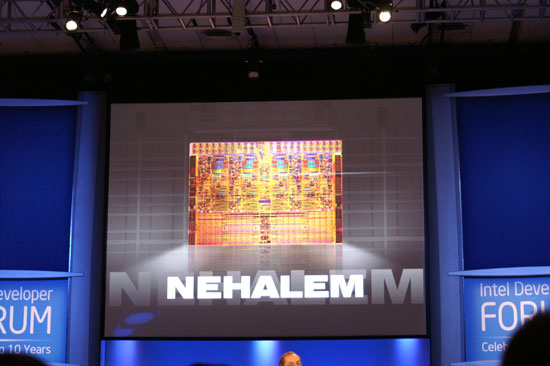
The Nehalem design is now complete, it was finished about a month ago, and Intel had a wafer of Nehalem at its 10-year anniversary IDF.

Each 4-core Nehalem is built from 731M transistors, nearly double that of Penryn. The 8-core variant isn't ready yet so we don't have a transistor count for that one as of this writing. Nehalem will sport an on-die memory controller and a new system interconnect called Intel's QuickPath Interconnect (Intel's answer to Hyper Transport).
Nehalem is fully expected to close the gap between AMD and Intel when it comes to memory performance and multi-processor scalability.
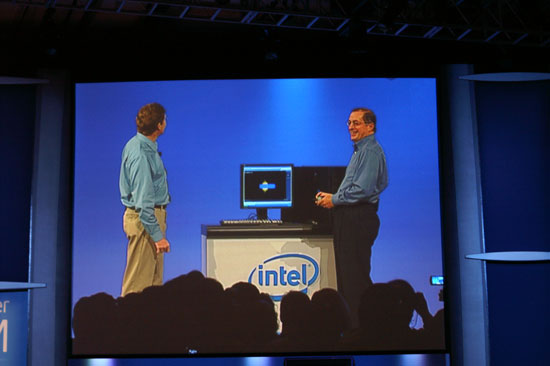
In its usual fashion, Intel demonstrated a fully functional Nehalem based on silicon that's only 3 weeks old. The silicon is booting both Windows XP and OS X, although we only saw the XP demo.
10x power reduction by 2010, err 2008
Otellini talked about Intel's plans for the ultra-mobile space, most of which we've already heard about.

Intel originally promised a 0.5W x86 processor by 2010 for use in Handtop PCs, and at this IDF we got an update: Silverthorne will hit that 0.5W mark in 2008, a bit earlier than originally expected. Intel did set a more granular goal for 2010, it plans to reduce idle power by 10x courtesy of its 32nm process.
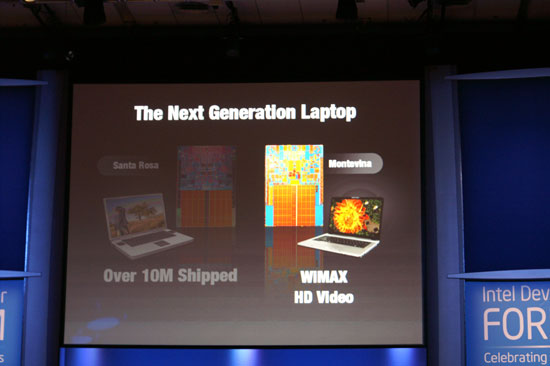
In the 2nd half of 2008 Intel will bring its second-generation mobile Penryn notebook to market, codenamed: Montevina.
XtremeSystems.org Demos 5.5GHz+ Quad-Core Yorkfield
Intel along with XtremeSystems ran a phase-change cooling demo of a ridiculously overclocked 45nm Yorkfield (quad-core Penryn) running at around 5.5GHz.
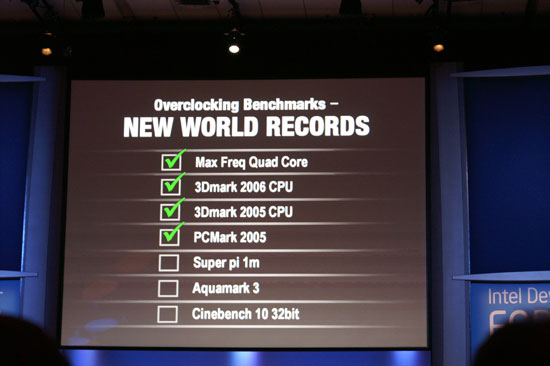
We saw a couple of world records broken, including a new world record for Cinebench R10 (32-bit).


A shot of the cooling system, three compressors chained together to bring CPU temperatures down to 160 below 0
Intel used the overclocking demo to talk about its upcoming X38 chipset launch, coming in October. Intel wants the X38 chipset to be embraced by enthusiasts hence the XS demo.
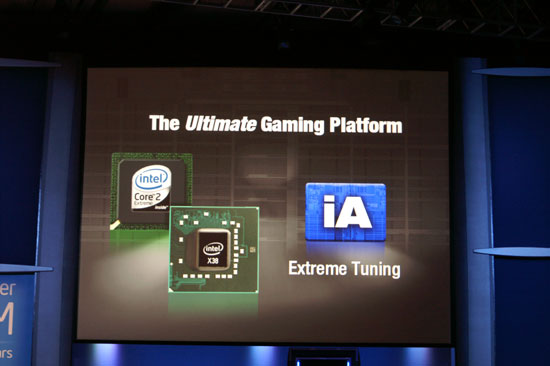
The Integrated Graphics Revolution
With the pending collision course between the CPU and the GPU, Intel confirmed that it would begin manufacturing its integrated graphics cores on smaller manufacturing processes moving forward.
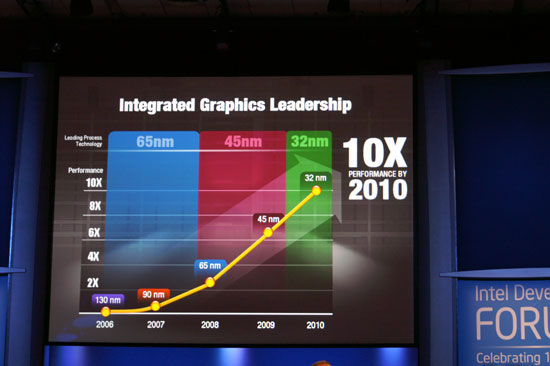
During the second half of Intel's 45nm era, Intel will bring the GPU on-die and plans to improve graphics performance significantly over where we're at today. The improvement is necessary in order to remain competitive with AMD's Fusion processors. From this point on, all integrated graphics will be on the microprocessor die.
By 2010, the first from-scratch CPU and GPU from Intel to be designed for 32nm will converge and we'll see a significant improvement in entry-level graphics performance.
One More Thing: Larrabee does Graphics
We've known that Larrabee would be Intel's discrete GPU, but Intel never confirmed it until today. Intel always talked about Larrabee as being great for scientific computing and financial applications, today it finally confirmed that it would also be great for graphics.

The Larrabee architecture hasn't been disclosed in detail but you can expect it to be an array of many simple, in-order x86 cores all behind a shared cache.
Larrabee is well into development and Intel expects to demonstrate it for the first time in 2008.
Intel Inside your TV?
Remember AMD's Bobcat? Here we have a block diagram of Intel's answer to the Bobcat based Imageon and Xileon processors.

Intel didn't have much to say about the architecture other than it was called Kenmore and we'd see it in 2008 in the Consumer Electronics market.
Something exciting about Intel getting into the CE market: it expects to see product development cycles shrink from multiple years down to 12 months for CE products, we likey.







